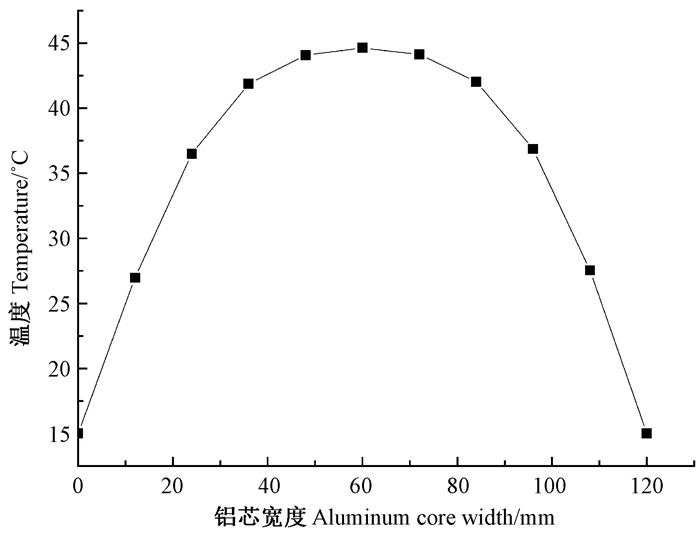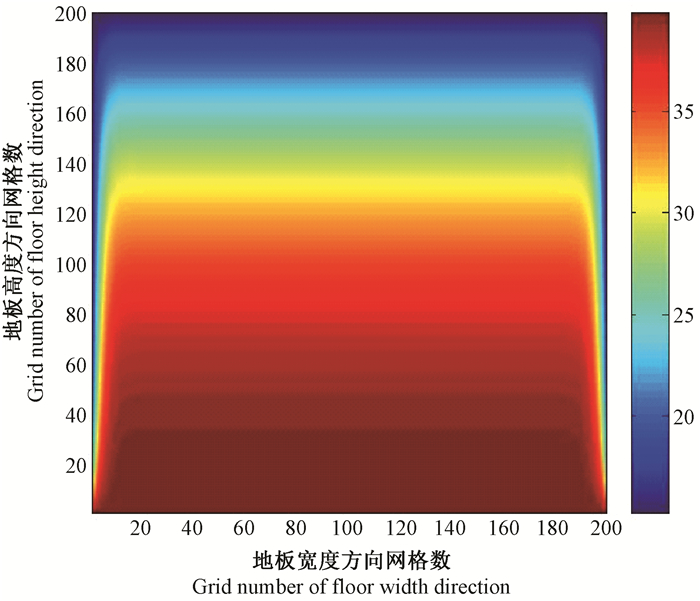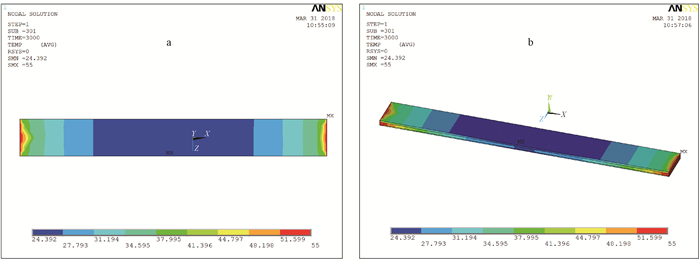文章信息
- 周玉成, 宋明亮, 马岩, 杨春梅, 张佳微, 邓英健, 蒋婷.
- Zhou Yucheng, Song Mingliang, Ma Yan, Yang Chunmei, Zhang Jiawei, Deng Yingjian, Jiang Ting.
- 太阳能储能地板设计及传热模型仿真分析
- Design of Solar Energy-Storage Flooring and Simulation Analysis of Heat Transfer Modeling
- 林业科学, 2018, 54(11): 149-157.
- Scientia Silvae Sinicae, 2018, 54(11): 149-157.
- DOI: 10.11707/j.1001-7488.20181121
-
文章历史
- 收稿日期:2018-04-04
- 修回日期:2018-08-28
-
作者相关文章
2. 东北林业大学机电工程学院 哈尔滨 150040
2. College of Mechanical and Electrical Engineering, Northeast Forestry University Harbin 150040
随着社会经济的发展及人民生活质量的提升,人们对室内采暖地板装饰也提高了要求(孙蕊等,2016)。实木复合地板物理力学性质稳定,不易变形开裂,有较好的加工性能和地热适应性能,且具有良好的保温、隔热等优点(田夏,2005;李冰,2007;马红霞等,2009;丁沪闽等,2011),在室内采暖地板装饰中得到了广泛应用。现今,地板辐射采暖系统主要有低温热水辐射采暖和发热电缆辐射采暖2种,低温热水辐射采暖以循环流动的热水为媒介,通过加热热水管来加热室内地板,地板面以对流和辐射的传热方式对室内供暖,热水一般由燃气、燃煤来提供,其煤气燃烧污染严重,安全性差,供暖成本高(全巍等,2017;刘立平等,2007);而发热电缆辐射采暖是由发热电缆提供热量对室内地板进行加热,会造成严重的电能消耗并存在较大安全隐患(牟湘芸,2012),系统整体利用率降低,且电能大部分通过火力发电得到,需要消耗大量的煤炭等不可再生资源(Zeng et al., 2009)。因此,在能源与环境问题日益凸显的今天,急需寻求新的清洁能源以解决上述问题。
太阳能是人类可以利用的最丰富的能源(蒋俊卿等,2013;张自国,2013),且在太阳能利用过程中不会产生废渣、废水、废气(卢奇,2012;陈进,2015)。鉴于此,本研究提出一种新型太阳能储能地板供暖系统,并结合理论和仿真方法对太阳能储能地板进行分析,推导出采暖系统的传热模型,辅以MATLAB仿真的数值模拟直观展现采暖地板的传热情况,以期为家用型供暖地板系统的设计和研究提供参考和理论基础。
1 太阳能储能地板总体设计 1.1 太阳能储能地板供热系统组成太阳能储能地板供热系统是一种将太阳能热水器的热能以及补热系统提供的热能传递到地板散热的装置,设计结构主要包括热能发生系统(含补热系统)、热能转换系统、热能传递系统、散热系统及其他保证室内温度的自动化控制系统,如图 1所示。

|
图 1 太阳能储能地板供热系统结构示意 Figure 1 The solar energy-storage flooring system structure diagram |
太阳能储能地板供暖系统主要是以太阳能辐射能作为能量来源,以整个地板面作为散热器,以导热铝芯作为传热媒介,通过在地板结构层内镶嵌铝板型材加热地板。太阳能热水器蓄热水箱中60~70 ℃的低温热水通过传热换热器将热能传递到传热铜管来加热铝芯,进而加热整个地板面,可使地板面温度上升20~29 ℃(王宝红,2012;聂磊,2014)。根据《中国地面辐射供暖技术规程》(JGJ 142—2016)》要求地面的设计温度为24~26 ℃,可知该供暖系统符合技术规程要求。图 2所示为室内加热铝芯地板系统的三维模型。

|
图 2 室内加热铝芯地板系统的三维模型 Figure 2 Three-dimensional model of the heating aluminum core floor system for indoor |
选择散热面积较大的铝板型材,对其进行结构设计,同时选择合适的隔热材料,建立铝板型材模型、地板块模型和隔热材料模型,然后加以装配。地板块规格根据实木复合地板标准尺寸设计,长1 210 mm、宽165 mm、高15 mm,地板块连接选择榫接拼装结构,并对地板块底部区域进行镂铣加工,镂铣深度为9 mm、宽度为120 mm,加工后将铝板型材嵌入地板块中,目的是导热快、散热效果好。根据地板块设计尺寸,选择蜂窝铝板型材厚度为5 mm、宽度为120 mm,长度根据室内铺装尺寸进行选择,最好整体式铺装,以避免由于地板块之间的传热铝板是接触式有缝连接而影响传热效率。蜂窝铝板型材可以增加传热过程中的散热面积,具有一定强度,且价格适宜。石棉保温板具有较好的绝热、保温性能,选择其作为室内供暖地板隔热材料,最佳厚度在3~6 mm之间,将保温板铺设在房屋基础层上。
图 3a为单个榫接地板装配模型,从上到下依次为实木复合地板块、2 mm厚铝板条、蜂窝铝板、2 mm厚铝板条和石棉保温板,在蜂窝铝板上下各加2 mm厚铝板条主要是为了加大散热面积,增加蜂窝铝板和实木复合地板的抗压强度,防止地板损坏并保证平整的贴合面。整个房间的三维设计地面铺装效果如图 3b所示,地板块之间采用交叉拼装,以增加地板面散热的均匀性和铺装的美观性。

|
图 3 太阳能储能加热铝芯地板三维模型 Figure 3 Three-dimensional model of the solar energy-storage heated aluminum core thermal floor a.单个榫接地板装配模型Single-mortised floor assembly model;b.加热铝芯导热地板室内铺装模型Heated aluminum core thermal floor indoor pavement model. |
热能发生系统包括太阳能集热器产热系统和电加热补热系统。集热器吸收太阳辐射能加热热水器水箱里的水,通过保温管道进入蓄热水箱中,热能转换系统的传热换热器将蓄热水箱中热水的热量传到导热性好的铜管上,实现能量二次转换。电加热补热系统是一种电加热器,加热装置置于蓄热水箱中,根据自动化控制器实时加热蓄热水箱里的水。太阳能利用受天气条件限制,白天阳光充足时,只需太阳能热水器运行对蓄热水箱里的水进行加热,为地板加热并提供用户生活热水;当太阳能辐射情况较差时,热水器提供的热能不能满足地板供热,需开启电加热补热系统,共同加热蓄热水箱里的水,进而加热地板;当阴雨天或夜晚室内供暖难以得到稳定可持续的保证时,需运行电加热补热系统,太阳能热水器供热停止,由电加热补热系统加热蓄热水箱里的水,为室内供热。
热能传递系统的传热换热器将热量传递到室内传热铜管上,蓄热水箱底部安装一个与传热铜管相连的微型静音水泵,静音水泵将热水输入传热铜管中,传热铜管埋在距墙面一定距离的位置,与铝芯相连形成四周闭环回路,中间安装温度控制止热开关,控制传热铜管的热量传递。铝芯将从热能传递系统得到的热量传递给地板,地板组成的散热系统传热时向房间自下而上散发热量,实现太阳能储能地板系统的供热过程。夜晚室外温度急剧下降时,太阳能热水器将不能再对水箱的水进行加热,控制器会切断热水器水循环,蓄热水箱里的热水仍可以持续为室内地板供热,当换热器温度低于室内空气温度时,控制器将发出指令关闭静音泵切断传热铜管对散热器加热,地板具有保温性能,能持续为房间供热。房间温度低于设定最低温度时,控制器会打开电加热补热系统对蓄热水箱进行补热。白天阳光充足时,电加热补热系统根据指令关闭,重复太阳能热水器的供热过程,控制器发出指令将水循环打开,继续给室内地板供热。太阳能加热铝芯导热地板系统的循环过程如图 4所示。

|
图 4 系统循环过程示意 Figure 4 System cycle process diagram |
自动化控制系统包括太阳能热水器控制、电加热补热系统控制、系统温度控制和水循环控制。对于水循环控制,采用定温控制和温差控制相结合的循环控制,系统根据蓄热水箱的水量和温度,按照一定阶段分别执行定温控制和温差控制来保证蓄热水箱的水温以满足房间供热温度要求,实现全天候供热(蔡满军等,2011;赵健等,2013;吴越等,2016)。
3 太阳能储能地板系统数学模型建立及传热仿真 3.1 热学模型传热分析对于实际供暖过程,建立一个近似真实情况的数学模型尤为必要。在建模过程中,可对实际情况稍作改变,以简化数值计算(何燕等,2015)。本设计可以简化成一个长×宽为5 m×4 m的房间模型,房间高度设为3 m,然后进一步假定房间只有一面外墙,其余三面均绝热,而且房间里没有人和其他房屋设施,门窗始终关闭,不考虑冷风侵入,边界条件与墙体相同。整个太阳能储能地板系统的热量传递过程如图 5所示。

|
图 5 热量传递过程 Figure 5 Heat transfer process Q1为太阳能热水器吸收的热量,Q2为太阳能水箱存储的热量,Q3为室内蓄热水箱的热量,Q4为传热铜管水循环系统传递的热量,Q5为传递到加热铝芯地板的热量,Qloss损为传热过程损失的热量。 Q1 is the heat absorbed by the solar-energy water heater, Q2 is the heat stored in the solar-energy water tank, Q3 is the heat of the indoor storage tank, Q4 is the heat transferred by the heat transfer copper pipe water circulation system, and Q5 is the heat of the heated aluminum core floor transferred, Qloss is the heat lost by the heat transfer process. |
根据热平衡方程(于秋红等,2015)
| $ {Q_{吸}} = {Q_{放}} $ | (1) |
可知,系统吸收的热量与放出的热量处于一个动态平衡的过程,由此可以得出:
| $ {Q_1} = {Q_2} + {Q_3} + {Q_4} + {Q_5} + {Q_{{\rm{loss}}}}。$ | (2) |
基于对太阳能储能地板的结构和传热分析,太阳能热水系统和电加热补热系统协调运作为蓄热水箱提供热能,而蓄热水箱为地板提供稳定热源,因此可以将铜管的传热部分视为稳定热源,对铝芯-地板-保温层系统建立传热数学模型。图 6所示为太阳能储能地板结构及其微元控制单元示意图,控制体为铝芯-地板-保温层系统,微元控制单元分为i-1单元、i单元和i+1单元,根据热平衡关系对各控制单元及控制体建立数学关系模型(杨世铭等,2007;张欢等,2017;张靖周,2015)。

|
图 6 太阳能储能地板结构及其微元控制单元 Figure 6 Structure and micro-element control unit of the solar energy-storage floor 1.实木复合地板Solid wood composite floor;2.连接体Connector;3.传热铜管Heat transfer copper tube;4.地基层Ground floor;5.传热铝芯Heat transfer aluminum core;6.保温层Insulation layer. |
建立稳态下铝芯控制体Va的热平衡关系:铝芯控制体Va内热量的增加Q=铝芯导热进入控制体Va的热量Qa+铜管与铝芯导热进入控制体Va的热量Qc+地板与铝芯导热进入控制体Va的热量Qw。稳态下铝芯控制体的热量增加为0,即Q=0。由于铜管处于热源,Qc为定值,因此可知,Q=Qa+Qc+Qw,通过计算可知铝芯控制体Va的热平衡方程为:
| $ \begin{array}{l} {\lambda _{\rm{a}}}{A_{\rm{a}}}\frac{{{t_{\rm{a}}}\left( {i - 1} \right) - 2{t_{\rm{a}}}\left( i \right) + {t_{\rm{a}}}\left( {i + 1} \right)}}{{\Delta l}} + \\ {Q_{\rm{c}}} + {A_{{\rm{a,w}}}}\frac{{{t_{\rm{w}}}\left( i \right) - {t_{\rm{a}}}\left( i \right)}}{{\frac{{{\delta _{\rm{w}}}}}{{2{\lambda _{\rm{w}}}}} + \frac{{{\delta _{\rm{a}}}}}{{2{\lambda _{\rm{a}}}}}}} = 0。\end{array} $ | (3) |
式中:λa为铝芯板的材导热系数,取值为238 W·m-1K-1;Aa为铝芯板断面面积(m2);ta(i)为铝芯控制体Va在单元i处的温度(℃);λw为实木复合地板的导热系数,取值为0.12 W·m-1K-1;δa、δw为铝芯和地板的有效厚度(m);Aa, w为铝板与地板的i控制体接触面积(m2);tw(i)为地板控制体Vw在单元i处的温度(℃)。
建立稳态下实木复合地板控制体Vw的热平衡关系:地板控制体Vw内热量的增加Q1=导热进入控制体Vw的热量Qe+地板与铝芯导热进入控制体Vw的热量Qw+地板表面与室内空气对流进入控制体Vw的热量Qs。稳态下实木复合地板控制体的热量增加为0,即Q1=0。因此可知,Q1=Qe+Qw+Qs,通过计算可知实木复合地板控制体Vw的热平衡方程为:
| $ \begin{array}{l} {\lambda _{\rm{w}}}{A_{\rm{w}}}\frac{{{t_{\rm{w}}}\left( {i - 1} \right) - 2{t_{\rm{w}}}\left( i \right) + {t_{\rm{w}}}\left( {i + 1} \right)}}{{\Delta l}} + \\ {A_{{\rm{a,w}}}}\frac{{{t_{\rm{a}}}\left( i \right) - {t_{\rm{w}}}\left( i \right)}}{{\frac{{{\delta _{\rm{w}}}}}{{2{\lambda _{\rm{w}}}}} + \frac{{{\delta _{\rm{a}}}}}{{2{\lambda _{\rm{a}}}}}}} + {\alpha _{\rm{d}}}A\left[ {{t_{\rm{n}}}\left( i \right) - {t_{\rm{w}}}\left( i \right)} \right] = 0。\end{array} $ | (4) |
式中:λw为实木复合地板的导热系数,取值为0.12 W·m-1K-1;Aw为实木复合地板控制体Vw的横截断面积(m2);A为地板单元i与接触空气的作用面积(m2);tn(i)为室内空气在单元i处的温度(℃);αd为实木复合地板控制体Vw与室内空气的对流换热系数(W·m-1K-1)。
由于地板面的换热过程属于自然对流换热,其特征是热平面朝上,因此:
| $ {\alpha _{\rm{d}}} = N{\mu _{{\rm{air}}}}\frac{{{\lambda _{{\rm{air}}}}}}{l}。$ | (5) |
式中:λair为空气导热系数,取值为0.022 W·m-1K-1;l为定型尺寸,即地板长与宽的平均值(m);Nμair为自然对流换热努塞尔数。
3.3 数学模型离散化由于控制体i-1、i和i+1是关于温度的方程,因此依据热量守恒定律,采用迭代法对数学模型进行简化并对其求解。首先将上述数学关系模型离散化,转化成各控制体方程,然后利用迭代进行求解。铝芯控制体的离散方程如下。
i=1时,离散方程为:
| $ {\lambda _{\rm{a}}}{A_{\rm{a}}}\frac{{{t_{\rm{a}}}\left( 2 \right) - {t_{\rm{a}}}\left( 1 \right)}}{{\Delta l}} + {Q_{\rm{c}}} + {A_{{\rm{a,w}}}}\frac{{{t_{\rm{w}}}\left( 1 \right) - {t_{\rm{a}}}\left( 1 \right)}}{{\frac{{{\delta _{\rm{w}}}}}{{2{\lambda _{\rm{w}}}}} + \frac{{{\delta _{\rm{a}}}}}{{2{\lambda _{\rm{a}}}}}}} = 0。$ | (6) |
i=2,…,n-1时,离散方程为:
| $ \begin{array}{l} {\lambda _{\rm{a}}}{A_{\rm{a}}}\frac{{{t_{\rm{a}}}\left( {i - 1} \right) - 2{t_{\rm{a}}}\left( i \right) + {t_{\rm{a}}}\left( {i + 1} \right)}}{{\Delta l}} + \\ {Q_{\rm{c}}} + {A_{{\rm{a,w}}}}\frac{{{t_{\rm{w}}}\left( i \right) - {t_{\rm{a}}}\left( i \right)}}{{\frac{{{\delta _{\rm{w}}}}}{{2{\lambda _{\rm{w}}}}} + \frac{{{\delta _{\rm{a}}}}}{{2{\lambda _{\rm{a}}}}}}} = 0。\end{array} $ | (7) |
i=n时,离散方程为:
| $ {\lambda _{\rm{a}}}{A_{\rm{a}}}\frac{{{t_{\rm{a}}}\left( {i - 1} \right) - {t_{\rm{a}}}\left( i \right)}}{{\Delta l}} + {Q_{\rm{c}}} + {A_{{\rm{a,w}}}}\frac{{{t_{\rm{w}}}\left( i \right) - {t_{\rm{a}}}\left( i \right)}}{{\frac{{{\delta _{\rm{w}}}}}{{2{\lambda _{\rm{w}}}}} + \frac{{{\delta _{\rm{a}}}}}{{2{\lambda _{\rm{a}}}}}}} = 0。$ | (8) |
地板控制体的离散方程如下。
i=1时,离散方程为:
| $ \begin{array}{l} {\lambda _{\rm{w}}}{A_{\rm{w}}}\frac{{{t_{\rm{w}}}\left( 2 \right) - {t_{\rm{w}}}\left( 1 \right)}}{{\Delta l}} + {A_{{\rm{a,w}}}}\frac{{{t_{\rm{a}}}\left( 1 \right) - {t_{\rm{w}}}\left( 1 \right)}}{{\frac{{{\delta _{\rm{w}}}}}{{2{\lambda _{\rm{w}}}}} + \frac{{{\delta _{\rm{a}}}}}{{2{\lambda _{\rm{a}}}}}}} + \\ {\alpha _{\rm{d}}}A\left[ {{t_{\rm{n}}} + {t_{\rm{w}}}\left( 1 \right)} \right] = 0。\end{array} $ | (9) |
i=2,…,n-1时,离散方程为:
| $ \begin{array}{*{20}{c}} {{\lambda _{\rm{w}}}{A_{\rm{w}}}\frac{{{t_{\rm{w}}}\left( {i - 1} \right) - 2{t_{\rm{w}}}\left( i \right) + {t_{\rm{w}}}\left( {i + 1} \right)}}{{\Delta l}} + }\\ {{A_{{\rm{a,w}}}}\frac{{{t_{\rm{a}}}\left( i \right) - {t_{\rm{w}}}\left( i \right)}}{{\frac{{{\delta _{\rm{w}}}}}{{2{\lambda _{\rm{w}}}}} + \frac{{{\delta _{\rm{a}}}}}{{2{\lambda _{\rm{a}}}}}}} + {\alpha _{\rm{d}}}A\left[ {{t_{\rm{n}}}\left( i \right) - {t_{\rm{w}}}\left( i \right)} \right] = 0。} \end{array} $ | (10) |
i=n时,离散方程为:
| $ \begin{array}{l} {\lambda _{\rm{w}}}{A_{\rm{w}}}\frac{{{t_{\rm{w}}}\left( {i - 1} \right) - {t_{\rm{w}}}\left( i \right)}}{{\Delta l}} + {A_{{\rm{a,w}}}}\frac{{{t_{\rm{a}}}\left( i \right) - {t_{\rm{w}}}\left( i \right)}}{{\frac{{{\delta _{\rm{w}}}}}{{2{\lambda _{\rm{w}}}}} + \frac{{{\delta _{\rm{a}}}}}{{2{\lambda _{\rm{a}}}}}}} + \\ {\alpha _{\rm{d}}}A\left[ {{t_{\rm{n}}} - {t_{\rm{w}}}\left( i \right)} \right] = 0。\end{array} $ | (11) |
1) 数值求解条件由于人体的生理温度和感觉舒适温度是不同的,所以室内温度保持在人的感觉舒适温度范围是模型建立的关键(刘艳峰等,2013)。蓄热水箱的供热水温一般为50~65 ℃,进行数值仿真时热源温度定为55 ℃,室内设计温度为15 ℃;铝芯板材的导热系数为238 W·m-1K-1,比热容为902 J·kg-1K-1,质量密度ρ=2 710 kg·m-3;实木复合地板主要材质为柞木,木材坚硬、耐磨、耐腐、耐冲击、稳定性好、保温性能好,其导热系数为0.14 W·m-1K-1,比热容为2 400 J·kg-1K-1,质量密度ρ=776 kg·m-3;石棉保温板导热系数为0.1 W·m-1K-1,比热容为816 J·kg-1K-1,质量密度为850 kg·m-3。
2) 数值求解仿真对上述模型及所需变量进行编程,程序输入到MATLAB软件中,将铝芯简化为长度为4 m、宽度为0.12 m的长条铝芯,便于设置边界条件及模型解算,完成边界条件及参数设定后进行调试,得到铝芯温度分布云如图 7所示。可以看出,铝芯宽度方向温度传热速度不同,长度方向温度呈现中间高、两端低的趋势。

|
图 7 铝芯的温度分布云 Figure 7 Temperature distribution cloud of aluminum core |
基于铝芯板材的温度分布云,可将2 m处铝芯宽度方向的温度数据提取出来,通过Origin 9.0软件的绘图功能进行数据统计,如图 8所示。可以看出,在稳态传热过程中,宽度横截面的温度分布呈抛物线形式,铝芯宽度方向温度呈中间高、两端低的趋势,总体温度大于30 ℃的比例较大,且温度分布在40 ℃左右的区间也较大,铝芯的传热效果较好。

|
图 8 铝芯板材2 m处宽度方向温度分布 Figure 8 Temperature distribution of aluminum core width direction in 2 m |
为找出合适温度计算地板截面的传热分布,可进一步将上述数据进行曲线拟合来计算温度占比。基于图 8的趋势选择二次曲线拟合,即抛物线数学模型,得到铝芯板材2 m处宽度方向温度分布曲线拟合如图 9所示。

|
图 9 铝芯板材2 m处宽度方向温度分布曲线拟合 Figure 9 Temperature distribution curve fitting of aluminum core width direction in 2 m |
通过曲线拟合,可得到二次曲线相应的系数,即a=-0.008 42,b=1.012 81,c=15.700 13,公式如下:
| $ \begin{array}{l} T = a{x^2} + bx + c = - 0.008\;42{x^2} + \\ 1.012\;81x + 15.700\;13。\end{array} $ | (16) |
其相关系数R2=0.989 5,值接近1,说明曲线拟合效果较好。得到了该温度曲线公式,可以较好预测铝材的温度分布。将曲线公式通过MATLAB编程得到不同温度下的区域示意,如图 10所示,可以清晰看出不同温度的区域范围,即S1、S2、S3。

|
图 10 不同温度下的区域示意 Figure 10 Area diagram in different temperatures |
表 1所示为通过程序计算得出的不同温度占比情况,可以看出,30、35 ℃时面积比和区间比的占比均较高,而40 ℃时,面积比和区间比基本稳定在50%左右,所以地板截面的温度仿真可以选择40 ℃来进行模拟。
|
|
基于上述分析,可以对地板某一截面进行传热仿真。地板截面的热接触面设定为40 ℃,通过编程仿真地板截面的温度分布云如图 11所示。可以看出,在一定时间内,地板传热速度较慢,与自身导热系数低有很大关系,这间接说明地板具有很大的蓄热能力,由于能量不断输入,地板将会储存较多热量并用于采暖。

|
图 11 地板截面的温度分布云 Figure 11 The temperature distribution of the floor crossing section |
将所建地板模型相应简化,形成3个平面式的地板-铝芯-保温层传热系统,利用SolidWorks软件进行三维建模,保存为有限元ANSYS可识别的fz.x_t文件,然后导入到ANSYS软件中进行相应的材料施加、接触添加、温度载荷添加,划分网格,最后进行求解,得出系统温度分布云如图 12所示。由图 12a可知,经过3 000 s模拟仿真求解,地板面温度分布基本呈两端高、中间低的趋势,最后稳定在24 ℃左右,符合室内采暖地板的温度要求。由图 12b可知,铝芯传热相较地板传热要快得多,与上述MATLAB的仿真结果一致,并且铝芯的传热速度较快。

|
图 12 太阳能储能地板供暖系统温度分布云 Figure 12 Temperature distribution cloud of the solar energy-storage floor system a.地板面温度分布云Floor surface temperature distribution cloud;b.供暖地板传热系统温度分布云Heating floor heat transfer system temperature distribution cloud. |
试验所用地板为实木复合地板,长1 210 mm、宽165 mm、高15 mm,试验器材有热水器、5 mm厚石棉保温板、铝板、连接装置、水管、T型铜-康铜热电偶温度传感器、GL820便携式绝缘多通道记录仪以及其他保温设施,室内设计温度为14 ℃。将上述试验材料进行拼装,并对拼装地板进行相应的隔热处理;热水器提供温度为55 ℃的热水,通过热水管对地板进行两端加热;将12个温度传感器间隔110 mm布置在地板纵向中间位置,共测量12个点的温度,历时30、40和50 min时各测1次。通过试验,得到地板面温度分布如图 13所示。可以看出,随着时间增加,地板面温度不断升高,升温50 min时,地板面的最低温度为20.5 ℃,与模型理论分析相比,其拟合度为85.42%,模型准确度较好。

|
图 13 不同温度下地板面温度分布 Figure 13 Temperature distribution of the floor surface under different temperatures |
1) 对室内地板供暖系统的主要工作过程进行分析,并基于系统传热过程对铝芯-地板-保温层系统建立传热数学模型。由铝芯温度分布云可知,铝芯宽度方向温度传热速度不同,长度方向温度呈中间高、两端低的趋势;总体温度大于30 ℃的比例较大,且温度分布在40 ℃左右的区间也较大,铝芯的传热效果较好。
2) 通过曲线拟合,得到铝芯板材2 m处宽度方向温度分布二次曲线,其相关系数R2=0.989 5,值接近1,曲线拟合效果较好。从地板截面、温度分布云可知,地板传热速度较慢,与自身导热系数有关。
3) 经过ANSYS软件模拟仿真,地板面温度分布基本呈两端高、中间低的趋势,最后稳定在24 ℃左右。
4) 随着时间增加,地板面温度不断升高,升温50 min时,地板面最低温度为20.5 ℃,拟合度为85.42%,模型准确度较好。
太阳能储能地板供暖系统利用传热性能较好的铝芯,由于仿真中所用铝芯是模型简化的铝芯,实际传热和模拟仿真传热会存在一定差别,但从仿真结果可知其传热效果还是较为明显的。本研究可为太阳能储能地板设计和研究提供一定的思路,有利于新时期太阳能储能地板的发展利用。
蔡满军, 吴磊, 董伟民. 2011. 低温地板辐射采暖系统分析与控制. 控制工程, 18(2): 185-187, 227. (Cai M J, Wu L, Dong W M. 2011. Analysis and control of low temperature floor radiation heating system. Control Engineering of China, 18(2): 185-187, 227. DOI:10.3969/j.issn.1671-7848.2011.02.007 [in Chinese]) |
陈进. 2015. 低温地板辐射采暖设计的探索与思考. 门窗, 256(2): 252-256. (Chen J. 2015. Exploration and thinking of low-temperature floor radiation heating design. Doors & Windows, 256(2): 252-256. [in Chinese]) |
丁沪闽, 张惠敏, 李权. 2011. 我国实木复合地板的发展现状与市场前景分析. 福建林业科技, 38(2): 156-158. (Ding H M, Zhang H M, Li Q. 2011. The development status and market prospects of solid wood composite flooring in China. Journal of Fujian Forestry Science and Technology, 38(2): 156-158. DOI:10.3969/j.issn.1002-7351.2011.02.38 [in Chinese]) |
何燕, 张晓光, 孟祥文. 2015. 传热学. 北京: 化学工业出版社. (He Y, Zhang X G, Meng X W. 2015. Heat transfer. Beijing: Chemical Industry Press. [in Chinese]) |
蒋俊卿, 王广东. 2013. 太阳能热泵低温辐射地板供暖系统研究. 煤气与热力, 33(11): 35-38. (Jiang J Q, Wang G D. 2013. Research on solar heat pump low temperature radiation floor heating system. Gas & Heat, 33(11): 35-38. DOI:10.3969/j.issn.1000-4416.2013.11.013 [in Chinese]) |
李冰. 2007. 低温热水地板辐射采暖系统的特点及应用. 华北水利水电学院学报, 28(4): 45-47. (Li B. 2007. Characteristics and application of low-temperature hot water floor radiant heating system. Journal of North China Institute of Water Conservancy and Hydroelectric Power, 28(4): 45-47. [in Chinese]) |
刘立平, 阙炎振. 2007. 太阳能热泵低温地板辐射供暖系统的研究与展望. 节能技术, (6): 550-553. (Liu L P, Que Y Z. 2007. Research and prospect of solar heat pump low temperature floor radiant heating system. Energy Saving Technology, (6): 550-553. DOI:10.3969/j.issn.1002-6339.2007.06.021 [in Chinese]) |
刘艳峰, 刘加平. 2003. 低温热水辐射地板传热平面肋片模型的改进. 哈尔滨工业大学学报, 35(10): 1190-1192. (Liu Y F, Liu J P. 2003. Corrected composite-fin model of heat conduction in embed-pipe heated floor. Journal of Harbin Institute of Technology, 35(10): 1190-1192. DOI:10.3321/j.issn:0367-6234.2003.10.011 [in Chinese]) |
卢奇. 2012.太阳能低温地板辐射采暖系统的研究.南京: 南京理工大学硕士学位论文. (Lu Q. 2012. Research on solar low temperature floor radiant heating system. Nanjing: MS thesis of Journal of Nanjing University of Science and Technology.[in Chinese]) |
马红霞, 江泽慧, 刘红征, 等. 2009. 我国实木复合地板研究现状及发展趋势. 世界林业研究, 22(4): 63-68. (Ma H X, Jiang Z H, Liu H Z, et al. 2009. Research status and development trend of solid wood composite flooring in China. World Forestry Research, 22(4): 63-68. [in Chinese]) |
牟湘芸. 2012. 浅谈低温地板辐射采暖的特点. 甘肃科技, 28(4): 115-116. (Mou X Y. 2012. Characteristics of radiant floor radiant heating. Gansu Science and Technology, 28(4): 115-116. DOI:10.3969/j.issn.1000-0952.2012.04.046 [in Chinese]) |
聂磊. 2014.太阳能采暖技术及其应用研究.秦皇岛: 燕山大学硕士学位论文. (Nie L. 2014. Solar heating technology and its application research. Qinhuangdao: MS thesis of Yanshan University.[in Chinese]) |
全巍, 何晓微, 高丽颖. 2017. 低温热水地板辐射采暖系统舒适与节能浅析. 供热制冷, (4): 27-29. (Quan Y, He X W, Gao L Y. 2017. Analysis of comfort and energy saving of low-temperature hot water floor radiant heating system. Heating & Refrigeration, (4): 27-29. [in Chinese]) |
孙蕊, 杭鑫, 陈煜, 等. 2016. 低温地板辐射采暖设计及其舒适性实验. 上海工程技术大学学报, 30(1): 11-16. (Sun R, Hang X, Chen Y, et al. 2016. Low-temperature floor radiation heating design and comfortable experiment. Journal of Shanghai University of Engineering Science, 30(1): 11-16. DOI:10.3969/j.issn.1009-444X.2016.01.003 [in Chinese]) |
田夏. 2005.低温热水地板辐射采暖地板构造及热过程研究.北京: 北京建筑工程学院硕士学位论文.
|
Tian X. 2015. Study on the structure and thermal process of low-temperature hot water floor radiant heating floor. Beijing: MS thesis of Beijing University of Civil Engineering and Architecture.[in Chinese]
|
王宝红. 2012. 低温地板辐射供暖理论计算模型. 河南科学, 30(6): 744-749. (Wang B H. 2012. Theoretical calculation model of low-temperature floor radiation heating. Henan Science, 30(6): 744-749. DOI:10.3969/j.issn.1004-3918.2012.06.020 [in Chinese]) |
吴越, 郭兴国, 彭冬根, 等. 2016. 低温地板辐射采暖传热分析. 建筑技术, 47(11): 970-973. (Wu Y, Guo X G, Peng D G, et al. 2016. Heat transfer analysis of low temperature floor radiation heating. Building Technology, 47(11): 970-973. DOI:10.3969/j.issn.1000-4726.2016.11.002 [in Chinese]) |
杨世铭, 陶文铨. 2007. 传热学. 北京: 高等教育出版社. (Yang S M, Tao W Q. 2007. Heat transfer. Beijing: Higher Education Press. [in Chinese]) |
于秋红, 鞠晓丽, 郝晓文, 等. 2015. 热工基础. 北京: 北京大学出版社. (Yu Q H, Ju X L, Hao X W, et al. 2015. Thermal engineering foundation. Beijing: Peking University Press. [in Chinese]) |
张欢, 陈志炜, 由世俊, 等. 2017. 带金属导热膜的新型地板辐射采暖热性能研究. 太阳能学报, 38(6): 1685-1691. (Zhang H, Chen Z W, You S J, et al. 2017. Thermo technical performance study of new type floor radiant heating system with metal heat conduction film. Acta Energiae Solaris Sinica, 38(6): 1685-1691. [in Chinese]) |
张靖周. 2015. 高等传热学. 北京: 科学出版社. (Zhang J Z. 2015. Advanced heat transfer. Beijing: Science Press. [in Chinese]) |
张自国. 2013. 使用太阳能的低温地板辐射供暖研究. 长春工程学院学报:自然科学版, 14(1): 108-109, 120. (Zhang Z G. 2013. Research on low-temperature floor radiation heating using solar energy. Journal of Changchun Institute of Technology:Natural Sciences Edition, 14(1): 108-109, 120. [in Chinese]) |
赵健, 张九根. 2013. 低温地板辐射采暖中的优化PID控制算法. 计算机仿真, 30(12): 365-368. (Zhao J, Zhang J G. 2013. Optimized PID control algorithm for low temperature floor radiant heating. Computer Simulation, 30(12): 365-368. DOI:10.3969/j.issn.1006-9348.2013.12.084 [in Chinese]) |
Zeng R L, Wang X, Zhang Y P, et al. 2009. Numerical study of thermal performance of phase change material energy storage floor in solar water heating system. Journal of Hunan University:Natural Sciences, 36(S1): 141-145. |
 2018, Vol. 54
2018, Vol. 54

